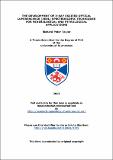Files in this item
The development of X-ray excited optical luminescence (XEOL) spectroscopic techniques for mineralogical and petrological applications
Item metadata
| dc.contributor.advisor | Finch, Adrian Anthony | |
| dc.contributor.advisor | Mosselmans, Fred | |
| dc.contributor.author | Taylor, Richard Peter | |
| dc.coverage.spatial | 300 | en_US |
| dc.date.accessioned | 2013-06-20T09:07:29Z | |
| dc.date.available | 2013-06-20T09:07:29Z | |
| dc.date.issued | 2013 | |
| dc.identifier.uri | https://hdl.handle.net/10023/3739 | |
| dc.description.abstract | This thesis investigates the use of X-ray Excited Optical Luminescence (XEOL) and Time Resolved X-ray Excited Optical Luminescence (TR XEOL) within the Earth sciences. The project contains two primary objectives, the first of which is the design and building of a high-resolution luminescence spectroscopy facility. This includes the installation and commissioning of the facility on the I18 microfocus beamline at Diamond, the UK's national synchrotron facility. In describing the system's design and commissioning, I explore many implications of the technique. The second objective is using this new facility to investigate a suite of minerals to develop new analytical techniques utilizing XEOL and TR XEOL spectroscopy for applications within the Earth sciences. An aspect of this investigation is to explore the potential of Time Resolved Optically Derived X-ray Absorption Spectroscopy (TR OD XAS) of substitute trace elements in minerals. To date CW OD XAS has been shown to have very limited application within the Earth sciences. (Soderholm et al., 1998-120) The thesis explores differences between photoluminescence (PL) and XEOL responses in mineral systems, and investigates how these differences can be exploited. Luminescence, the phenomenon upon which the thesis is based, is a complex and poorly utilised phenomena within Earth sciences, it is however, orders of magnitude more sensitive, than many of the more accepted techniques used for the detection of trace elements, on this basis alone I would suggest it deserves further consideration. Luminescence techniques have developed much further in other disciplines; I therefore have incorporated many descriptions, models, and interpretations from other disciplines in order to identify methodologies and techniques that have the potential to be utilized in the study and interpretation of luminescence within the Earth sciences. The thesis demonstrates that luminescence in minerals with measured lifetimes, as fast as ~ 20 ps exist. Previously the recorded luminescent lifetimes, for minerals, in the literature are measured in ns. This finding leads to the novel concept that the measurement of TR XEOL with ps resolution combined with the measurement of the intensity of a luminescent signal as a function of excitation can provide significant new insights into the nature of the emission and the luminescent processes. I explore and demonstrate the potential of using dose dependence techniques of continuous wave and TR XEOL as a new analytical technique. I also demonstrate the use of a technique used extensively within Biology has an application with Earth sciences. The methodology incorporates the calculation of the natural lifetime of an emission through the relationship between the absorption and emission coefficients. (Strickler and Berg, 1962). I discuss how knowledge of the natural lifetime of an emission allows quantification of luminescence through measurement of a modified lifetime of emission. The quantification of a luminescent emission has significant potential within the geosciences one example being the identification of disputed emissions. I also consider the potential to use TR XEOL techniques in mapping complex heterogeneous rocks and minerals. | en_US |
| dc.language.iso | en | en_US |
| dc.publisher | University of St Andrews | |
| dc.subject | XEOL | en_US |
| dc.subject | TR XEOL | en_US |
| dc.subject | TRPL | en_US |
| dc.subject | Feldspar | en_US |
| dc.subject.lcc | QC476.6T2 | |
| dc.subject.lcsh | Luminescence spectroscopy | en_US |
| dc.subject.lcsh | Time-resolved spectroscopy | en_US |
| dc.subject.lcsh | Minerals--Defects--Analysis | en_US |
| dc.subject.lcsh | Earth Sciences--Methodology | en_US |
| dc.subject.lcsh | X-ray spectroscopy | en_US |
| dc.title | The development of X-ray excited optical luminescence (XEOL) spectroscopic techniques for mineralogical and petrological applications | en_US |
| dc.type | Thesis | en_US |
| dc.contributor.sponsor | Diamond Light Source | en_US |
| dc.type.qualificationlevel | Doctoral | en_US |
| dc.type.qualificationname | PhD Doctor of Philosophy | en_US |
| dc.publisher.institution | The University of St Andrews | en_US |
This item appears in the following Collection(s)
Items in the St Andrews Research Repository are protected by copyright, with all rights reserved, unless otherwise indicated.

